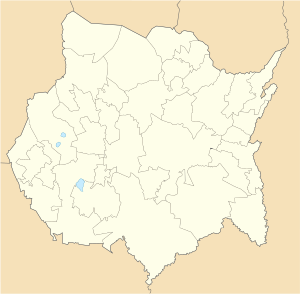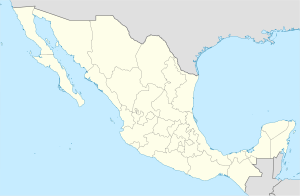Totolapan facts for kids
Quick facts for kids
Totolapan
|
|
|---|---|
|
City and Municipality
|
|
| Country | |
| State | Morelos |
| Founded | Between 1150 and 1350 |
| Municipal Status | May 17, 1930 |
| Area | |
| • Municipality | 67,798 km2 (26,177 sq mi) |
| Elevation | 1,901 m (6,237 ft) |
| Population
(2010) Municipality
|
|
| • Municipality | 10,790 |
| Time zone | UTC−6 (CST) |
| • Summer (DST) | UTC−5 (CDT) |
| Postal code |
62830 – 62835
|
| Area code(s) | 735 |
| Website | Official website : https://www.totolapan.gob.mx/web |
Totolapan is a town and a municipality in the northern part of the Mexican state of Morelos. It is surrounded by the State of Mexico to the north, and by other towns like Tlayacapan and Atlatlahucan to the south and east. To the west, you'll find Tlalnepantla.
The town of Totolapan is the main center for the surrounding municipality, and they share the same name. In 2015, about 11,992 people lived in the municipality.
The name Totolapan comes from the Nahuatl language, which was spoken by ancient people in Mexico. It means "birds on water." The full name is Totolapan de Montes de Oca. This longer name honors Fernando de Montes de Oca, a young soldier who bravely died during the Mexican–American War in 1849 at the Battle of Chapultepec.
History of Totolapan
Early Settlers and Empires
The very first people to live in this area were the Chichimecas. They called the land Totalapan. Later, between the years 1150 and 1350, the Xochimilcas moved into the territory. Even later, the famous Aztec ruler Moctezuma also had control over Totolapan. At that time, Totolapan was part of a larger area called Huaxtepec.
Spanish Arrival and New Beginnings
When the Spanish arrived in Mexico, Hernan Cortés sent his captain, Gonzalo de Sandoval, to take control of Huaxtepec. In 1519, Totolapan also became part of the lands taken during the Spanish Conquest.
After the conquest, some lands were given to a Spanish person named Diego Olguín in 1536. However, when a special area called the Marquisate of the Valley of Oaxaca was created, Totolapan became part of it.
Monastery and World Heritage
The native people in Totolapan were taught about Christianity by the Augustinians, a group of monks. In 1545, they built the beautiful Monastery of San Guillermo Abad. Fray Jorge de Ávila was in charge of its construction. This monastery is very special because it is one of the Monasteries on the slopes of Popocatépetl that have been recognized as World Heritage Sites by UNESCO. This means it's a place of great importance to everyone in the world!
Changes Over Time
In 1742, Totolapan and nearby communities became part of Chalco. Then, on January 1, 1813, these areas were divided and became parts of Cuernavaca and Cuautla.
Mexican Revolution and Modern Times
In 1910, people in the area saw a comet near the Popocateptl volcano. Many believed it was a sign, and this convinced them to join the forces of Emiliano Zapata during the Mexican Revolution. There were even some battles at the old monastery and on a hill called Cerro de Santa Barbara.
More recently, Sergio Omar Livera Chavarria was elected as the Municipal President (like a mayor) on July 1, 2018. One of his main goals is to make sure laws are followed and to prevent people from taking justice into their own hands.
The Indigenous community of Hueyapan became self-governing on January 1, 2018, which means they manage their own affairs.
During the global health situation in 2020, schools and many businesses in Totolapan had to close for a while.
Life in Totolapan
Town Layout and Education
The town of Totalapan is made up of four traditional neighborhoods, called barrios: La Purísima, Barrio San Agustín, Barrio San Marcos, and Barrio San Sebastián.
For education, there are three preschools, four public elementary schools (for grades 1-6), and one middle school (for grades 7-9). Totolapan is about 59.2 kilometers (36.8 miles) northeast of Cuernavaca and 97.8 kilometers (60.8 miles) south of Mexico City.
Other Communities and Economy
Besides the main town, there are other smaller communities in the municipality. Some of these include Ahuatlan, Nepopualco, and Santa Bárbara.
Most people in Totolapan work in farming. They grow crops like corn, beans, and oats. They also grow fruits such as peaches, pears, apples, tejocote (a yellow fruit), and capulín (a type of cherry). Raising animals is also important, with cattle, pigs, goats, sheep, and horses. Beekeeping, which is raising bees for honey, is also a big activity. Almost half of the people in Totolapan also work in construction and making things.
Fun Places to Visit
There are many interesting places to see in Totolapan!
Nature and Views
- Ecological Park Los Venados: This park, located in the community of Nepopualco, is a great place to enjoy nature. "Los Venados" means "the deer," so you might even see some!
- Santa Barbara Hill: This hill is perfect for peaceful walks during the day. It offers amazing views of the town below and was even used as a lookout spot during the Mexican Revolution.
- El Aljibe Hill: This name means "place where water is stored." If you visit this hill, you can see deep valleys and fields. It's about a 40-minute walk to a cave that has an old water storage system inside. A special ceremony is held here every May 3rd.
Historic Chapels
You can also find several old chapels from the colonial times:
- San Miguel y Santiago in Nepopualco.
- San Agustín in Tepetlixpita.
- San Sebastián in La Cañada.
- San Pablo in San Miguel.
- The ruins of the chapel of La Asunción in Ahuatlán.
The San Guillermo Abad Monastery
The most famous attraction is the Ex-Convento de San Guillermo de Abad. It was built starting in 1534 by Fray Jorge de Ávila and the Augustinian monks. As mentioned before, it's part of the Monasteries on the slopes of Popocatépetl World Heritage Site.
This monastery has a very large open area called an atrium, which was designed for big religious parades. There are also three smaller chapels called posa chapels, including one connected to the main church. These were built for Indigenous people who had not yet been baptized.
The convent building itself is made of stone and has only one floor. Inside the church, there's a wide altar with a statue of San Guillermo. You can also see unique decorations like fake monograms and carved stones. This is the only 16th-century convent with this kind of special artwork! What's also special is that it's one of the few old convents that still has its original garden area. The paintings inside the church, with their red geometric shapes, are still in great condition. Outside, the stone facade has carved designs, including one of Christ. The side chapels still have their original altars. You can also find two oil paintings that show scenes from the life of Fray Antonio de Roa. On the south side of the church, a large door leads to the cloister, which is a covered walkway. Here, you can see paintings of St. Augustine, along with pictures of plants and other designs.
Geography and Nature
Location and Mountains
Totolapan is located at about 18°58' North latitude and 98°55' West longitude. It sits at an altitude of about 1,897 meters (6,224 feet) above sea level in an area known as Los Altos de Morelos (The Highlands of Morelos).
The most important mountains nearby are El Coaltepec (2,500 meters or 8,202 feet high), el Huitzomayor (2,500 meters or 8,202 feet high), el Partido (2,054 meters or 6,739 feet high), and el Citlaltépetl (1,948 meters or 6,391 feet high). Other hills include Cerro del Loreto, Volcán del Aire, and Santa Bárbara. About 7.41% of the area is mountainous, 74.62% is semi-flat, and 17.95% is covered by plants. The mountains are mostly in the north and northeast, but the south also has some hills. The central and southern parts of the municipality have valleys and plains.
Land and Water
The municipality covers an area of about 57.33 square kilometers (22.14 square miles). There are no large rivers or lakes in Totolapan. A lot of the land is used for farming (3,406 hectares or 8,416 acres), some for raising animals (75 hectares or 185 acres), and a good portion is covered by forests (1,212 hectares or 2,995 acres). All of the land is communal, meaning it belongs to the community.
Climate, Plants, and Animals
Totolapan has a subtropical-humid climate. This means it's usually warm and gets a good amount of rain. The average temperature is about 17.4°C (63.3°F), and it receives about 913 millimeters (35.9 inches) of rain each year.
In the northern parts, you'll find forests with trees like oak, pine, and madroño (a type of strawberry tree). In the south, there are different kinds of trees that lose their leaves, such as casahuate, tepehuaje, guaje, palo dulce, amate blanco, and copal.
The animals living here are also very interesting! You might see white-tailed deer, raccoons, skunks, and squirrels. There are also special animals like the mouse of the volcanoes, pumas (also known as mountain lions), and different kinds of birds like the Moctezuma quail, mountain hen, blue magpie, and goldfinch. For reptiles, there are rattlesnakes, viper rats, frogs, and lizards.



